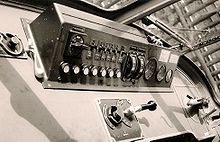Driver's cab



The driver's cab (driver's cab) of a rail vehicle describes the place or space for the vehicle driver . It contains the controls that are necessary to operate the vehicle .
Today, a driver's cab is usually designed either as a driver's cab or as part of the superstructure. This applies in particular to modern locomotives , in which driver's cabs are predominantly located at the ends of the vehicle. In the shunting locomotives used are often designed with a central cab.
In the early days of the railway, the locomotive crew had to do their work completely unprotected outdoors. In order to protect the crew from the bad weather, the driver's cab of locomotives, especially those running at higher speeds, was increasingly equipped with a roof and protective walls, as can be seen in the documented conversion of the American locomotive John Bull . There the attached tank wagon or tender was equipped with a cabin by the railway company and the roof was pulled up over the driver's cab. In the case of the high- speed Crampton locomotives in Europe around 1850, at least a poor windshield was placed in front of the driver's cab.
In Germany , the Saxon railway director and writer Max Maria von Weber introduced the closed driver's cab. Up until 1950, however, the railway directorates of the German-speaking countries were of the opinion that a standing working posture was essential in order to raise awareness. Since around the 1920s, the driver's cabs in German-speaking countries have been provided with Spartan seats, which, however, were initially only intended for use during breaks. In addition to rheumatism among the steam train drivers , who had to lean out of the window to get a better view, frequent occupational diseases were also worn knee joints among the electric train drivers. This only changed - with a few exceptions - with the construction of the German express railcars and the electric locomotives of the E 18 series , which were set up for driving while sitting for the first time. In the meantime, it was possible to secure the driver's attention by technical means via the safety driving circuit. In contrast, the driver's cabs of North American steam locomotives were often designed for seated operation by the driver even before 1900.
In contrast to the past, the driver's cabs of trams are now often separated from the passenger compartment in order to allow the vehicle driver undivided attention to his work; however, the passenger usually still has a view of the route. Up until a few years ago, the driver's cab was completely separated from the passenger compartment of the railcars and control cars of underground , suburban and mainline trains . It has only recently become customary to allow interested passengers to take part in route monitoring; Examples are the Intercity - control car and ICE-3 trains of the DB . With the latter, the glass partition behind the driver's cab can be electrically darkened to prevent a view in certain situations ( ICE lounge ).
Related topics
- The German Federal Railroad standardized the so-called DB standard driver's cab .
- The European Driver's Desk (EUDD), which is used in Europe, is a further development of this .
- Driver's cabs are built for training purposes and equipped with large screens for train simulations .
- Controls of a steam locomotive
literature
- Werner Geier: The driver's cab of modern electric locomotives . In: Eisenbahn-Revue International , Issue 12/2002, ISSN 1421-2811 , pp. 550–555.


